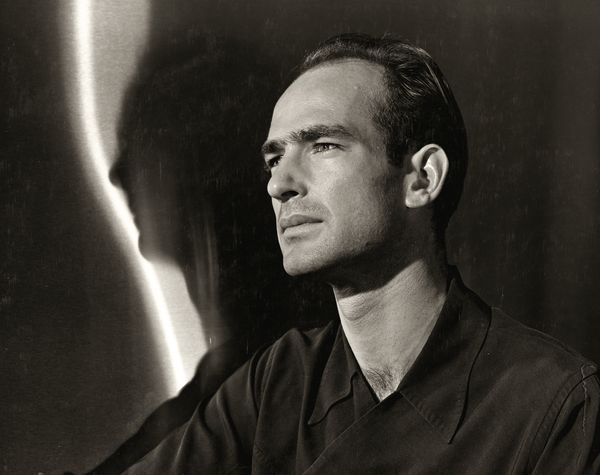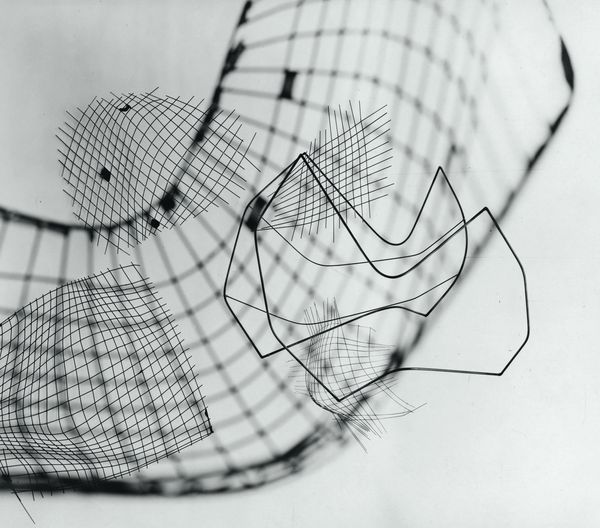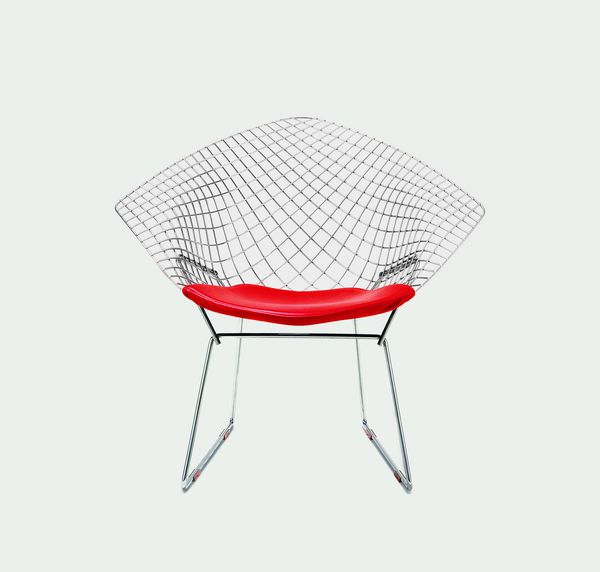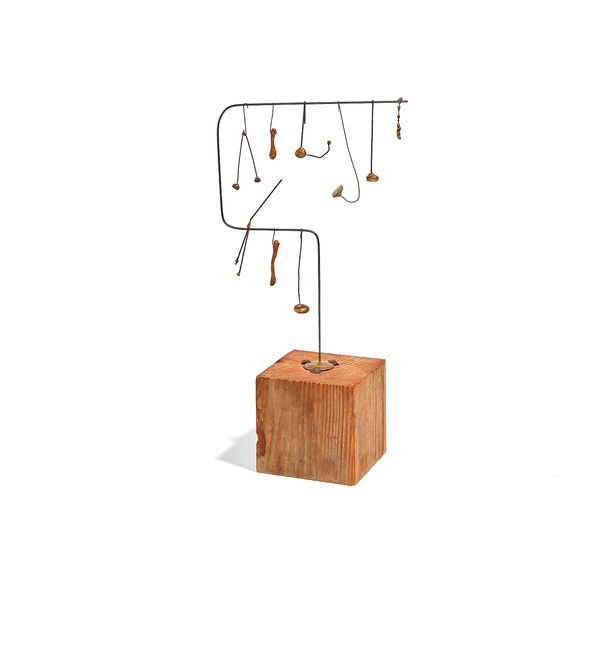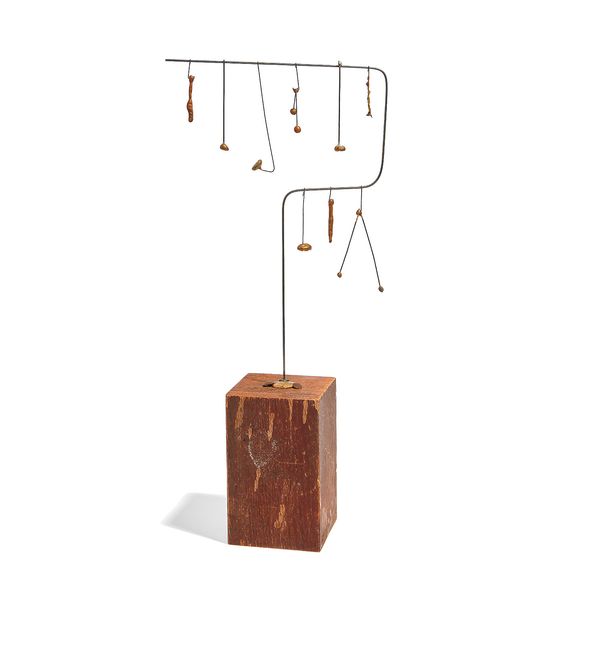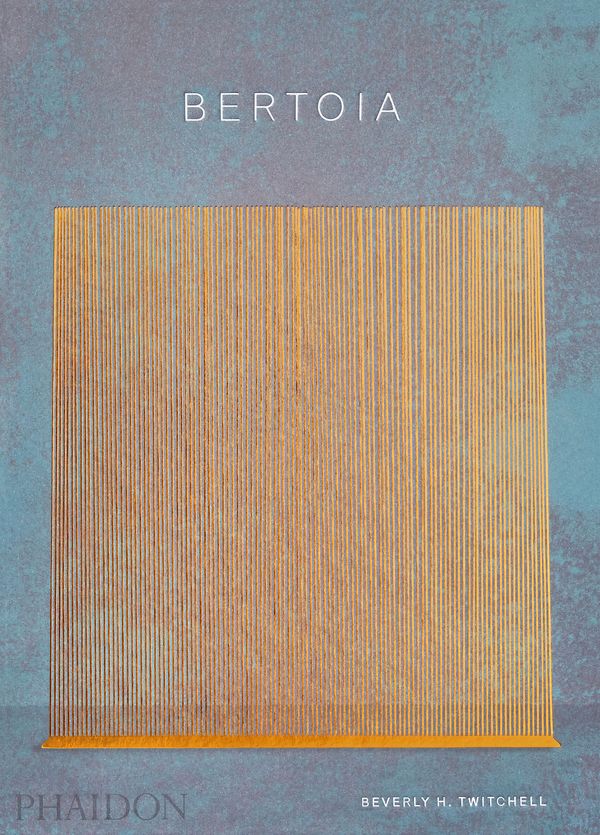Joe Munroe Portrait of Harry Bertoia in July 1942. Picture credit: Cranbrook Archives, neg. 5985-1. Photo: © Cranbrook Archives.
Herbert Matter Photomontage of studies for Bertoia chairs, c. 1951–52. Photo: Herbert Matter, Courtesy of Knoll, Inc.
While working for Knoll, [Harry] Bertoia was also making small wire sculptures and graphics upstairs in the shop in Bally. A Herbert Matter photograph from about 1952 directly conveys the relationship between Bertoia’s works in two realms. Matter must have appreciated the difference between the irregular cells of the sculpture and the Side Chair’s more consistent intervals.
Harry Bertoia Bertoia Small Diamond Chair (model 421), 1952. Photo: Courtesy of Knoll, Inc.
As Bertoia’s ties to Knoll grew more informal, he increasingly used the chair’s material in new, freer ways to make sculpture from wire. The earliest wire sculptures are among the most playful of Bertoia’s entire oeuvre. He made these wire constructions in a quick, intimate, often whimsical way that must have been a pleasurable contrast to the pressure of his downstairs work, which was much more practical, problem-solving involvement with chairs.
Lot 55, Harry Bertoia Kinetic Sculpture, circa 1948
After beginning on a small scale, the wire constructions would gradually grow in size and complexity. First, they gained irregular textures that increased their organic character and volume, as Bertoia melted other metals onto the wires using a torch. Soon small shapes in sheet steel made their way into sculptures, gradually increasing in size and prominence in a logical progression to become what Bertoia would call multiplane constructions. These multiplane constructions had their origins in the three-dimensional “wood-block paintings” and in his 1943 Cranbrook experiment taking the block monotypes into the third dimension by using wires within a wooden frame to support squares of white paper at various heights and distances. That antecedent of his multiplane constructions was only about 15 inches (38.1 cm) high and twice as wide. Bertoia’s early planar constructions would be the genesis of his major early commissions, the ones that would join the chairs in making his name in the art world.
(left to right) Herbert Matter, Hans Knoll, Florence Knoll, and Harry Bertoia, early 1950s. Photo: Courtesy of Knoll, Inc.
Melting brass or other metals with a torch along wires and across surfaces left swirls, puddles, streaks, and drops that varied the mass and texture of the metal; traces of motion left by the movement of the torch in his hand created surfaces that caught light at many angles and transformed geometric, industrial materials into interesting forms that appear almost natural. Bertoia’s experience with brazing in making chairs had introduced him to results of this technique, which, though undesirable in chairs, could be appealing in a context where they could be expressive. This process allowed Bertoia to give movement and texture to surfaces in a manner approximating the heavy impasto of oil paint that painters, especially Abstract Expressionists like Willem de Kooning and Arshile Gorky, were then using in their works. There is no knowing if this parallel in effects resulted from influence, confluence, or chance. The simplicity, scale, and character suggest that this technique is from his time with Knoll.
Lot 56, Harry Bertoia Kinetic Sculpture, circa 1948
The “wood-block paintings” are evidence that small pieces of wood often shared Bertoia’s work space with him. In order to use both hands while fabricating an untitled kinetic sculpture from about 1948, even in its early stages he had to mount it on something—his workbench or a block of wood. He may have originally attached the largest wire to the block of spruce that ended up serving as the sculpture’s base, but it would have been typical of Bertoia’s methods to have grabbed a convenient and serviceable scrap of wood and later, pleased by or interested in the work, transferred it to that cleaner block. Bending the largest wire into an approximate question mark, Bertoia hung from it an eccentric group of wires, including inverted Ys and pieces with globular or curved ends. The largest wire nearly surrounds most others, but a few escape and dangle below. The pendant elements are light enough to sway, adding motion similar to that of brooches, earrings, and pendants he had made a few years earlier. Although mounting this group of wires was done out of necessity while making it, the block also adds to the finished work’s height and increases the space it commands. Humble and delightful, the work is a direct and important link between Bertoia’s jewelry and sculpture.
Learn more about Bertoia: The Metal Worker at Phaidon >
